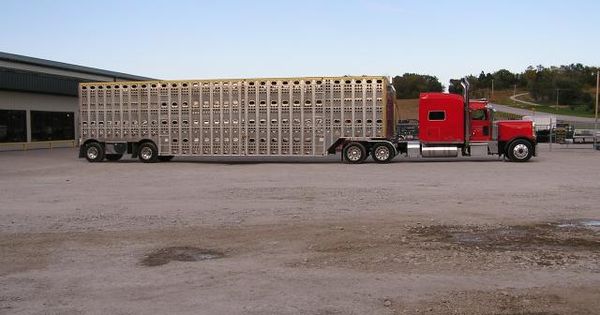Farm & Ranch
Pump the Brakes on MAP-21

By Jessica Crabtree
In July of 2012 a law was signed enforcing the use of federal Electronic Logging Devices (ELDs) by the Department of Transportation’s Federal Motor Carrier Safety Administration (FMCSA) labeled as MAP-21. In this article we will present what is known, how it will affect livestock haulers and projected concerns if MAP-21 goes into effect. By the time this issue prints, the mandate may or may not go into effect, hinging on the chance an exemption is allowed, giving livestock haulers more time to adapt for change.
Why the mandate was proposed.
In a recent article by Drovers on www.drovers.com on Nov. 10, 2017, it stated the regulations proposed were in an attempt to create safer driving conditions and aid in eliminating the need for paper logs.
Why would MAP-21 not work for livestock haulers?
In the ELD rule, truckers have an hourly service limit. Plainly put, truckers have a service limit of 11 hours of driving in a 24-hour period. They can be on duty a total of 14 hours consecutively, including the 11 hours of driveling time said above. After those 11 hours are reached, the driver must stop and rest, allowing for 10 consecutive hours off duty.
Where things get difficult for livestock haulers is in the matter of hauling living creatures. Such rules raise animal welfare concerns. Why some may ask? Due to the chance of cross contamination and unintentional biosecurity hazards.
Particulars about MAP-21.
For commercial motor vehicles, as of Dec. 18, 2017, the federal Electronic Logging Device (ELD) rule, which is regulated by the United States Department of Transportation (DOT), will begin. An ELD is a record-keeping device that is synchronized to the truck’s engine and has the capability to log information digitally in real-time. An ELD is able to record data, such as time spent on the road, number of miles driven, location and amount of hours the engine was running. While this may not be an issue for truckers transporting paper goods, clothing items and non-perishable things, it is not feasible for the welfare of livestock hauling. The voluntary introductory phase for ELDs began Dec. 16, 2015.
To read more about MAP-21 pick up a copy of the January 2018 NTFR issue. To subscribe call 940-872-5922.
Farm & Ranch
Hazards of Backyard Poultry

By Barry Whitworth, DVM
Having backyard poultry is a popular agriculture enterprise. According to the United States Department of Agriculture, 0.8 percent of all households in the United States have chickens. People keep chickens for a variety of reasons with table eggs being one of the more common reasons.
Unfortunately, some of these poultry producers are not aware of the hazards that come with keeping poultry because many times they carry pathogens but appear healthy.
Chickens are carriers of several zoonotic diseases. These are diseases that can be passed from animals to humans. According to a recent survey in Pennsylvania, a majority of backyard poultry producers were aware of the dangers of avian influenza. However, this study also revealed that far fewer producers were aware of the risk of possible exposure to Salmonella and Campylobacter.
The lack of knowledge about the hazards of raising poultry likely contributes to the continued issues of Salmonella outbreaks associated with backyard poultry. In 2023, the Centers for Disease Control and Prevention reported 1,072 illnesses of Salmonella linked to backyard poultry, and 272 of those patients required hospitalization. Oklahoma reported 43 individuals with the disease.
To read more, pick up a copy of the April issue of NTFR magazine. To subscribe by mail, call 940-872-5922.
Farm & Ranch
Ag Elsewhere: Wyoming

By Tressa Lawrence
Babies are tucked away in every nook and cranny. Many ranchers across Wyoming have baby animals popping up all over this time of year.
Farm & Ranch
Ag Elsewhere: Montana

By Lindsey Monk
Another load of grain in to keep feeding the calves until the green grass can really start popping.
-

 Country Lifestyles1 year ago
Country Lifestyles1 year agoScott & Stacey Schumacher: A Growth Mindset
-

 Equine7 months ago
Equine7 months agoThe Will to Win
-

 Country Lifestyles7 years ago
Country Lifestyles7 years agoStyle Your Profile – What your style cowboy hat says about you and new trends in 2017
-

 Country Lifestyles4 years ago
Country Lifestyles4 years agoAmber Crawford, Breakaway Roper
-

 HOME7 years ago
HOME7 years agoGrazing North Texas – Wilman Lovegrass
-

 Country Lifestyles7 years ago
Country Lifestyles7 years agoDecember 2016 Profile, Rusty Riddle – The Riddle Way
-

 Country Lifestyles8 years ago
Country Lifestyles8 years agoJune 2016 Profile – The man behind the mic: Bob Tallman
-

 Outdoor9 years ago
Outdoor9 years agoButtercup or Primrose?






